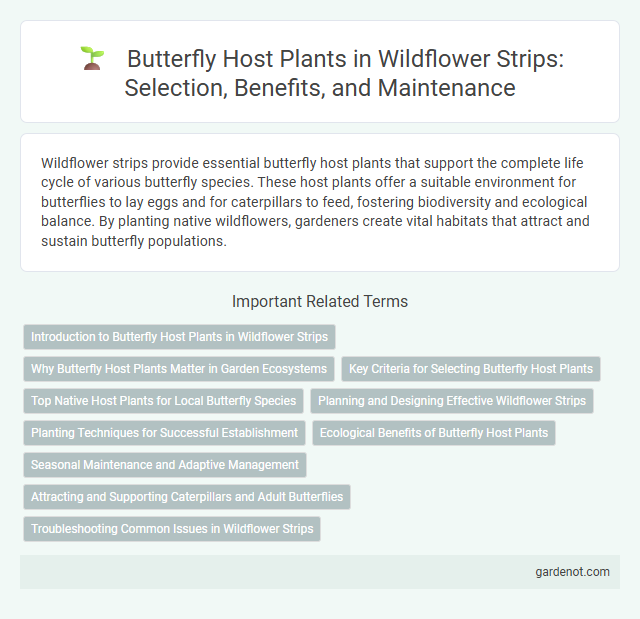Wildflower strips provide essential butterfly host plants that support the complete life cycle of various butterfly species. These host plants offer a suitable environment for butterflies to lay eggs and for caterpillars to feed, fostering biodiversity and ecological balance. By planting native wildflowers, gardeners create vital habitats that attract and sustain butterfly populations.
Introduction to Butterfly Host Plants in Wildflower Strips
Butterfly host plants in wildflower strips provide essential habitat for caterpillars, supporting the life cycle of butterflies and promoting biodiversity. Common host plants include milkweed for monarchs, parsley for black swallowtails, and violets for fritillaries, creating a diverse ecosystem. Integrating these plants into wildflower strips enhances pollinator populations and strengthens ecological balance.
Why Butterfly Host Plants Matter in Garden Ecosystems
Butterfly host plants are essential for the survival and reproduction of many butterfly species, providing a critical food source for their larvae. These plants support biodiversity and help maintain balanced garden ecosystems by attracting pollinators and other beneficial insects. Incorporating native butterfly host plants in a wildflower strip enhances pollination, promotes ecological resilience, and fosters a healthy garden environment.
Key Criteria for Selecting Butterfly Host Plants
Selecting butterfly host plants requires focusing on species that provide suitable foliage for caterpillar development, such as milkweed for monarchs or fennel for swallowtails. Consider regional adaptability to ensure plants thrive in local soil and climate conditions, enhancing survival rates. Prioritize native plants to support local butterfly species, promote biodiversity, and maintain ecological balance within wildflower strips.
Top Native Host Plants for Local Butterfly Species
Top native host plants for local butterfly species play a crucial role in supporting butterfly populations by providing essential nourishment and breeding sites. Milkweed, violet, and dill are among the most effective host plants for attracting monarchs, fritillaries, and swallowtails, ensuring their larvae have access to the nutrients needed for development. Incorporating these native species into a wildflower strip fosters biodiversity and enhances the survival rate of native butterflies.
Planning and Designing Effective Wildflower Strips
Effective wildflower strip planning for butterfly host plants requires selecting native species that provide optimal larval food sources and nectar throughout the growing season. Designing strips with a diversity of flowering times and structural complexity supports various butterfly life stages and promotes habitat stability. Incorporating spatial arrangement techniques, such as clustering host plants near nectar sources, enhances butterfly colonization and population sustainability.
Planting Techniques for Successful Establishment
Strategic planting techniques for butterfly host plants in wildflower strips include selecting native species that align with local butterfly lifecycles to ensure larval food availability. Proper soil preparation and spacing optimize root development and reduce competition, supporting robust plant growth. Timing of planting during early spring or fall maximizes establishment success before peak butterfly activity, enhancing habitat suitability.
Ecological Benefits of Butterfly Host Plants
Butterfly host plants play a crucial role in the ecological balance by providing essential habitats and nourishment for various butterfly species, aiding in their life cycle from caterpillar to adult. These plants support biodiversity by attracting pollinators, which enhances plant reproduction and contributes to a healthier ecosystem. Integrating butterfly host plants in wildflower strips promotes natural pest control and strengthens local food webs, increasing overall environmental resilience.
Seasonal Maintenance and Adaptive Management
Seasonal maintenance of butterfly host plants in wildflower strips involves monitoring growth stages and removing invasive species to ensure optimal habitat conditions. Adaptive management practices include adjusting planting schedules and species selection based on annual climate variations and butterfly population responses. Regular assessment supports biodiversity conservation and enhances pollinator support throughout the growing season.
Attracting and Supporting Caterpillars and Adult Butterflies
A wildflower strip rich in native milkweed, parsley, and dill provides essential host plants that attract monarch and swallowtail caterpillars, supporting their development. Incorporating a variety of nectar-rich flowers like coneflowers, asters, and goldenrod sustains adult butterflies by supplying continuous food sources throughout their life cycles. Maintaining a pesticide-free environment and diverse plant species enhances habitat quality, promoting a thriving butterfly population in both caterpillar and adult stages.
Troubleshooting Common Issues in Wildflower Strips
Butterfly host plants in wildflower strips may face common issues such as poor soil drainage, pest infestations, and inadequate sunlight, which can hinder their growth and butterfly attraction. Regular monitoring for signs of fungal disease or caterpillar damage is essential to maintain plant health and support butterfly larvae development. Implementing proper irrigation, selecting disease-resistant host species, and promoting habitat diversity can significantly improve the survival and effectiveness of butterfly host plants in wildflower strips.
Butterfly host Infographic

 gardenot.com
gardenot.com